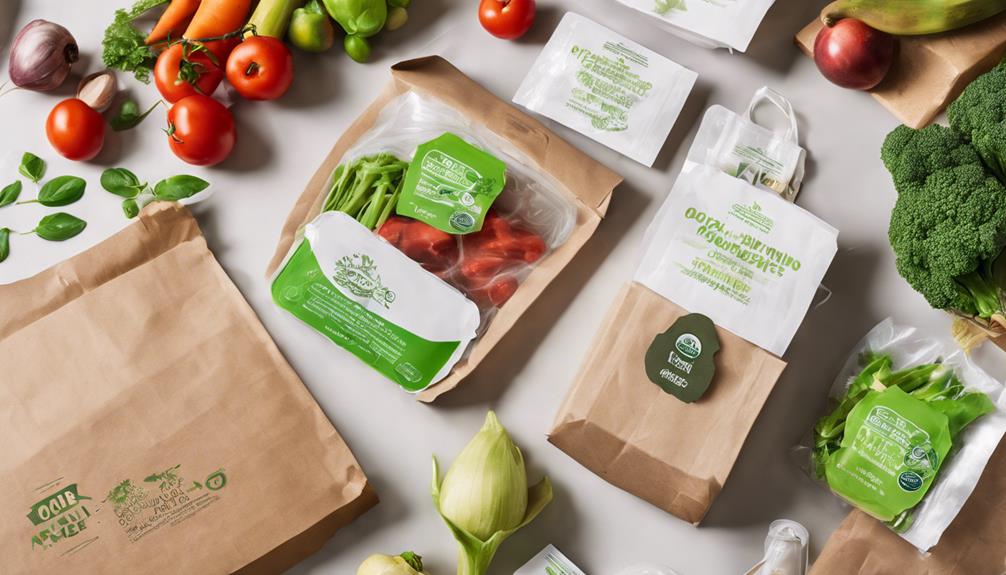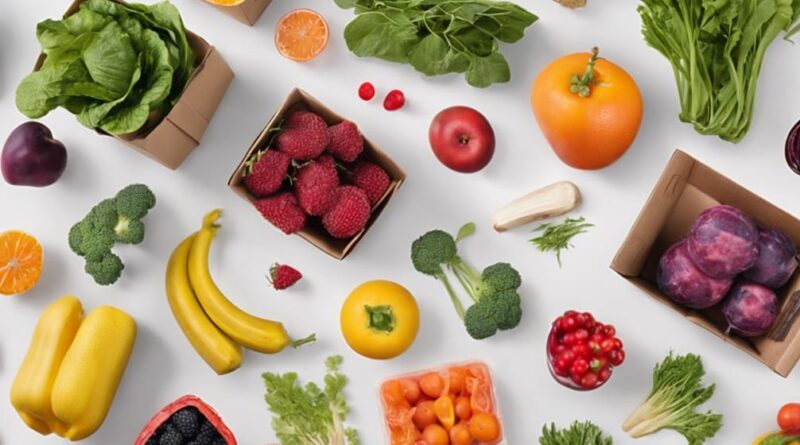What Ensures Freshness in Organic Food Packaging?
To ensure freshness in organic food packaging, sustainable materials, air-tight sealing techniques, UV protection, temperature control, responsible sourcing, and innovative eco-packaging solutions are key. Biodegradable packaging reduces environmental impact, while vacuum sealing and oxygen absorbers maintain freshness. UV protection shields from degradation, and temperature control prevents harmful bacteria growth. Ethical labeling ensures responsible practices. Minimizing food waste through storage efficiency is crucial. Innovations like compostable materials further sustainability efforts. Embracing these elements guarantees organic food stays fresh, safe, and eco-conscious. Explore more about maintaining freshness in organic food packaging with comprehensive sustainable practices and innovative solutions.
Importance of Fresh Organic Food
Fresh organic food plays a crucial role in promoting overall health and well-being due to its higher nutrient content and absence of harmful chemicals. When it comes to the benefits of fresh organic food, the nutritional aspect stands out prominently. Research indicates that organic produce contains higher levels of essential vitamins, minerals, and antioxidants compared to conventionally grown counterparts. This increased nutrient content is attributed to the sustainable farming practices employed in organic agriculture, which focus on maintaining soil health and biodiversity.
In terms of sustainability, fresh organic food production emphasizes environmentally friendly practices such as crop rotation, natural fertilizers, and biological pest control. These methods not only ensure the quality of the food but also contribute to the long-term health of the ecosystem. Organic farming techniques help preserve water resources, reduce pollution, and support overall biodiversity, making it a more sustainable option for both consumers and the environment.
When it comes to quality, fresh organic food is held to rigorous standards that prohibit the use of synthetic pesticides, hormones, and genetically modified organisms. This commitment to quality assurance ensures that consumers are receiving food products that are free from potentially harmful substances, thereby safeguarding their health and well-being. By choosing fresh organic options, you aren't only nourishing your body with superior nutrition but also supporting a more sustainable and environmentally conscious food system.
Sustainable Packaging Materials
Organic food's commitment to sustainability extends beyond farming practices to encompass the use of eco-friendly materials in its packaging. When it comes to sustainable packaging materials for organic food, two key options stand out: biodegradable options and recycled materials.
Biodegradable packaging materials are designed to break down naturally over time, reducing their impact on the environment. These materials, often made from plant-based sources like cornstarch, sugarcane fibers, or even mushrooms, offer a renewable and compostable alternative to traditional plastics. By opting for biodegradable packaging, organic food producers can minimize waste and pollution, aligning with their eco-conscious values.
Recycled materials play a crucial role in sustainable packaging by giving new life to existing resources. Using materials such as recycled paper, cardboard, or glass reduces the need for virgin materials, conserving energy and resources in the production process. Incorporating recycled content into packaging not only decreases the environmental footprint but also encourages a circular economy where materials are reused and recycled continuously.
Air-tight Sealing Techniques
Utilizing advanced air-tight sealing techniques is essential in ensuring the longevity and freshness of organic food products during storage and transportation. Vacuum sealing is a widely used method that removes air from the packaging before sealing it. This process helps preserve the freshness of organic foods by slowing down the oxidation process, which is a major factor in food spoilage. By eliminating oxygen from the packaging, vacuum sealing benefits organic food products as it reduces the growth of aerobic bacteria and molds that require oxygen to thrive.
In addition to vacuum sealing, the use of oxygen absorbers is another effective technique for extending the shelf life of organic food products. Oxygen absorbers are small packets that contain iron powder and salt, which react to oxygen by creating iron oxide. This reaction reduces the oxygen levels inside the packaging, thereby slowing down the deterioration of organic foods caused by oxidation. By limiting the presence of oxygen, oxygen absorbers help maintain the freshness of organic food products for a longer duration.
UV Protection for Product Longevity
To enhance the longevity of organic food products and shield them from potential deterioration, implementing UV protection measures is crucial. Light exposure, especially ultraviolet (UV) rays, can accelerate the degradation of organic foods, leading to a shorter shelf life. UV radiation can initiate chemical reactions in organic matter, causing changes in flavor, texture, and nutritional value. Therefore, packaging materials that offer UV protection play a vital role in maintaining the quality of organic products.
UV protection in packaging involves incorporating barriers that can block or absorb harmful UV rays. This can be achieved by using UV-blocking films or adding UV absorbers to the packaging material. These measures help prevent UV light from penetrating the packaging and reaching the organic food products, thus minimizing the risk of degradation.
When organic foods are exposed to UV light for prolonged periods, the likelihood of spoilage increases, affecting their shelf life. By implementing UV protection measures in packaging, you can significantly extend the freshness and quality of organic food products. This not only benefits consumers by ensuring they receive products with optimal nutritional content and flavor but also reduces food waste by preventing premature spoilage. In conclusion, UV protection is a crucial aspect of organic food packaging that contributes to preserving product integrity and extending shelf life.
Temperature Control in Packaging
Implementing precise temperature control measures within packaging is essential for preserving the freshness and quality of food products. Maintaining the cold chain, which refers to the uninterrupted storage and distribution of perishable products under controlled temperatures, is crucial in organic food packaging. The cold chain helps prevent the growth of harmful bacteria and maintains the food's nutritional value. By ensuring that organic products are consistently stored at the optimal temperature throughout their journey from production to consumption, you can significantly extend their shelf life and quality.
Moisture control is another critical aspect of temperature management in packaging. Excessive moisture can lead to mold growth, spoilage, and degradation of organic products. Packaging materials with moisture barrier properties can help regulate humidity levels and prevent moisture from affecting the food products. Proper ventilation within the packaging can also aid in controlling moisture and maintaining the product's freshness.
To guarantee the effectiveness of temperature control measures, it's essential to use temperature-monitoring devices such as data loggers or indicators. These tools help track temperature fluctuations during storage and transportation, allowing you to identify any deviations from the recommended conditions promptly. By implementing robust temperature control mechanisms and incorporating moisture control strategies in organic food packaging, you can uphold the freshness, quality, and safety of the products throughout the supply chain.
Ethical Labeling Practices
Ethical labeling practices play a vital role in transparently communicating the sourcing, production methods, and values associated with organic food products. When it comes to organic food packaging, ethical sourcing is a key aspect that consumers look for. Transparent labeling allows consumers to make informed decisions by providing information on where the ingredients were sourced from and how the product was produced. This transparency builds trust between consumers and producers, emphasizing the ethical values upheld throughout the production process.
Ethical sourcing involves ensuring that the ingredients used in organic food products are sourced in a responsible and sustainable manner. This includes considerations such as fair trade practices, supporting local farmers, and promoting environmentally friendly production methods. By clearly labeling the sources of ingredients and the production practices used, consumers can verify if the product aligns with their ethical values.
Transparent labeling goes beyond just listing ingredients; it also includes certifications and labels that indicate compliance with organic standards, fair trade practices, or other ethical guidelines. These labels provide consumers with assurance that the product meets specific ethical criteria. Additionally, detailed information on packaging regarding ethical practices can help consumers understand the impact of their purchase decisions on social and environmental issues. Overall, ethical labeling practices not only benefit consumers by enabling informed choices but also encourage producers to uphold high ethical standards in the organic food industry.
Minimizing Food Waste

Minimize food waste by adopting efficient storage and inventory management practices in organic food packaging. Sustainable practices play a crucial role in reducing spoilage and ensuring that organic products reach consumers in their freshest state. Proper storage techniques, such as maintaining optimal temperature and humidity levels, are essential for preserving the quality of organic foods. Implementing inventory management systems that track expiration dates and prioritize the use of perishable items can help minimize waste by ensuring that products are used before they spoil.
In addition to efficient storage and inventory management, reducing food waste in organic food packaging involves strategic planning and forecasting. By accurately predicting consumer demand and adjusting production levels accordingly, companies can avoid overproduction and prevent excess inventory from going to waste. This practice not only benefits the environment by reducing the amount of discarded food but also contributes to cost savings for businesses.
Another key aspect of minimizing food waste in organic food packaging is establishing clear protocols for handling and processing products throughout the supply chain. Proper handling procedures, such as careful sorting and inspection of incoming ingredients, can help identify potential issues early on and prevent spoilage before it occurs. By incorporating sustainable practices into every stage of the packaging process, organic food manufacturers can effectively reduce waste and increase the overall freshness of their products.
Innovations in Eco-Packaging
In the realm of sustainable packaging solutions, cutting-edge innovations are revolutionizing the landscape of eco-friendly packaging for organic food products. Biodegradable solutions and green packaging innovations are at the forefront of this movement towards more environmentally friendly packaging options. Biodegradable solutions refer to packaging materials that can be naturally broken down by microorganisms into non-toxic components, reducing the impact on the environment.
One of the most significant advancements in eco-packaging is the development of biodegradable films made from materials like plant-based plastics, cellulose, or starch. These films offer a sustainable alternative to traditional plastic packaging, which can take hundreds of years to decompose. By using biodegradable films, organic food producers can reduce their carbon footprint and minimize waste generation.
Another innovative approach to eco-packaging is the use of compostable packaging materials. Compostable packaging is designed to break down into natural elements in a compost environment, leaving no toxic residues behind. This not only reduces the amount of waste sent to landfills but also provides valuable nutrients for the soil.
Conclusion
In conclusion, ensuring freshness in organic food packaging requires a combination of sustainable materials, air-tight sealing techniques, UV protection, temperature control, ethical labeling practices, and innovative eco-packaging solutions.
By implementing these strategies, food waste can be minimized and product longevity can be enhanced. It's crucial for companies to prioritize these factors in order to maintain the quality and integrity of organic products throughout the packaging and distribution process.
